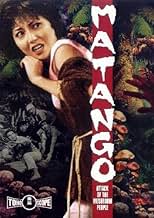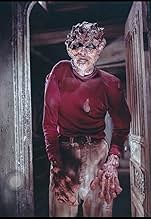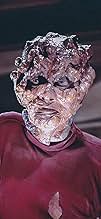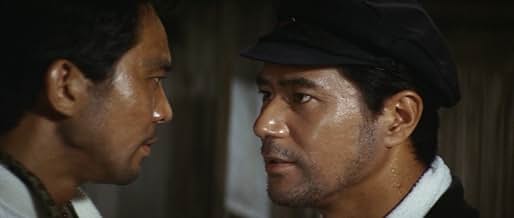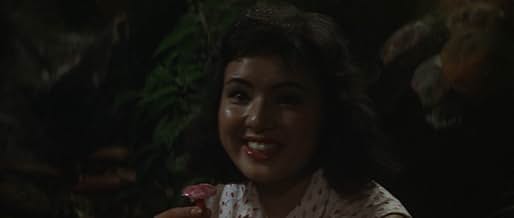PUNTUACIÓN EN IMDb
6,4/10
3,8 mil
TU PUNTUACIÓN
Añade un argumento en tu idiomaShipwrecked survivors slowly transform into mushrooms.Shipwrecked survivors slowly transform into mushrooms.Shipwrecked survivors slowly transform into mushrooms.
- Dirección
- Guión
- Reparto principal
Takuzô Kumagai
- Doctor
- (as Jirô Kumagai)
Reseñas destacadas
First a correction : the making year and distribution release year in Japan of MATANGO is 1962 and not 1963. It is of course a very good movie from Inoshiro Honda, the father of "Kaiju Eiga" and every cinephile knows what that means. Besides, it is a "Kaiju eiga" (= "monster movie" as trasnlated in English) quite closer to horror than to science-fiction, even it is also a sci-fi, including mentions of the atom research in the ghost boat in which the survivors are living. It is closer to BINJO TO EKITAI NINGEN [L'HOMME H] (Jap. 1958) than to GOJIRA (Jap. 1954), both directed by Honda, if you want to have a comparative idea. Anyway, it is a very original movie in Honda carrier. Even it can remind, as a cultivate reader mentionned it, a W.H.Hodgson's novel. But were the Japanese scriptwriters aware of that source ? Interesting question. I am glad to announce you that in France, a smart distributor has bought the rights from Toho and distributed that movie in a beautiful Cinemascope complying with 16/9 TV screening : it has been shown on Canal + private famous French TV but I do not think it is available on DVD or video.
It was around one or two years ago and we have been able to discover it in original japanese langage with French subtitles : beautiful master and beautiful movie. Honda is my favorite horror and sci-fi movie director with regard to history of Japanese movie. I have recently written an "Elementary filmography of Kaiju Eiga" in which Inoshiro Honda has of course the main place, as far as Toho is concerned. MATANGO is a masterpiece.
It was around one or two years ago and we have been able to discover it in original japanese langage with French subtitles : beautiful master and beautiful movie. Honda is my favorite horror and sci-fi movie director with regard to history of Japanese movie. I have recently written an "Elementary filmography of Kaiju Eiga" in which Inoshiro Honda has of course the main place, as far as Toho is concerned. MATANGO is a masterpiece.
10Kabumpo
The cast of this film all consider it one of their proudest achievements. This film is about false friendships, utter hatred, and abandonment of values. Constructed from William Hope Hodgson's rather simple horror story, in which a man hailing a schooner for food tells how the virtuous (abstinent) unmarried couple (himself and his fiancee) were in a shipwreck and tried to make their home on an island encrusted with fungus, first in a ship and then in two tents on an unidentified sandy substance, only to eat the fungus and become it, takes on a whole new dimension by placing the man, here a psychology professor, and his student fiancee with a rich couple together only for the money, a serious writer, and the two-man crew. Though they never abandon the fungus-encrusted ship for tents, they soon become embittered over food, and the men all want the virgin, not the rich showgirl. Hodgson was on the way to becoming a minister before he was killed in WWI, and his story is explicitly Christian. This film takes out explicit religion (though the Japanese version has a brief scene related to Akiko's Shinto beliefs, which was deleted because most Americans wouldn't understand it), but retains the morals. The psychologist is unable to cope with the degrading values, particularly after the mate is shot over money (useless) and turtle eggs (food). The skipper takes the ship (which isn't his, Kasai wearing a captain's uniform to prove it (and how stuck up he is)) after repairing it, without anyone else, but he dies at sea, Murai soon finding the abandoned ship. The voyage reveals the true character of the relationships with one another, and their attempts to break down the virtuous couple, which ends with the psychologist in the asylum, where he tells his story. He gets succumbed, too. "My friends are alive; I'm the one who died," he tells them. The crew dead, his friends are left on the island, slowly merging with the fungus...
MATANGO, directed by Ishiro Honda, is an exceptionally beautiful fantasy film from the mighty Toho. Bastardized for its American release, badly dubbed, retitled ("Attack of the Mushroom People") and afforded very little respect, its recent re-emergence as a special edition DVD confirms its place in the realm of fantastique cinema.
What makes this amazing film so effective is its seductively spare but intelligent screenplay, nightmarish atmosphere, serenely creepy score and stunning special effects. Tonally, it recalls underrated Japanese genre flicks such as "The Mistress in a Cave", "Horror of Malformed Men" and the delightful "Living Skeleton". Like the mushrooms the shipwrecked survivors of a pleasure craft are drawn to, it seduces us with its simple structure, pleasing taste and rich subtext.
The film operates on a number of thematic levels, but Honda's achievement is that he never allows the dense thematics to weigh the very human drama down. Like all classic stories of survival, human greed, envy, love and hunger are the engines of the conflict. The search for a state of being free of responsibility and consequences is the dream driving the conflicted.
It is of curious interest to me that the characters in this "uncharted island" fantasy include a Skipper, a Millionaire, a Professor, a First Mate and a Girl Next Door. Produced before "Gilligan's Island" debuted on American TV, it could surely be argued that this orchestration of characters was a template for Sherwood Schwartz, the creator of "Gilligan's Island".
A palpable sadness permeates the last twenty minutes of MATANGO, a sense of blinding melancholy that elevates it to a dizzying level of achievement.
MATANGO explores how we are all drawn to pleasures that we know may sign our death warrants while daring to suggest that death by pleasure is a demise more preferable to death without love.
Stunning.
What makes this amazing film so effective is its seductively spare but intelligent screenplay, nightmarish atmosphere, serenely creepy score and stunning special effects. Tonally, it recalls underrated Japanese genre flicks such as "The Mistress in a Cave", "Horror of Malformed Men" and the delightful "Living Skeleton". Like the mushrooms the shipwrecked survivors of a pleasure craft are drawn to, it seduces us with its simple structure, pleasing taste and rich subtext.
The film operates on a number of thematic levels, but Honda's achievement is that he never allows the dense thematics to weigh the very human drama down. Like all classic stories of survival, human greed, envy, love and hunger are the engines of the conflict. The search for a state of being free of responsibility and consequences is the dream driving the conflicted.
It is of curious interest to me that the characters in this "uncharted island" fantasy include a Skipper, a Millionaire, a Professor, a First Mate and a Girl Next Door. Produced before "Gilligan's Island" debuted on American TV, it could surely be argued that this orchestration of characters was a template for Sherwood Schwartz, the creator of "Gilligan's Island".
A palpable sadness permeates the last twenty minutes of MATANGO, a sense of blinding melancholy that elevates it to a dizzying level of achievement.
MATANGO explores how we are all drawn to pleasures that we know may sign our death warrants while daring to suggest that death by pleasure is a demise more preferable to death without love.
Stunning.
Toho are mostly known for their dark bleak period pieces and their goofy monster flicks, but every once in a while they delved into something else and Matango is a great example of this.
Well ahead of its time it tells the story of ship wreck survivors trying to make it until help comes, but they don't appear to be alone on the island and tensions are beginning to build.
So okay I admit the concept is daft, the antagonists are a bit silly but lets be honest they aren't a million miles from those in The Last of Us (2013). Despite this they actually do the job quite well and look considerably better than you'd imagine considering this was the early 60's.
The film is a real slow burner and very little of it features the antagonists at all, the majority is the turmoil between survivors but it does this to a passable degree.
Though not everything it could have been there is a lot to be impressed over in Matango and it's a neat little forgotten Toho movie that deserves attention.
The Good:
Looks excellent for its time
Some good ideas
The Bad:
Cast and characters are pretty forgettable
Very slow burn
Things I Learnt From This Movie:
An opportune time to tell a woman you love her for the first time is straight after hitting her
Could easily have had a sequel about killer cheese people
Well ahead of its time it tells the story of ship wreck survivors trying to make it until help comes, but they don't appear to be alone on the island and tensions are beginning to build.
So okay I admit the concept is daft, the antagonists are a bit silly but lets be honest they aren't a million miles from those in The Last of Us (2013). Despite this they actually do the job quite well and look considerably better than you'd imagine considering this was the early 60's.
The film is a real slow burner and very little of it features the antagonists at all, the majority is the turmoil between survivors but it does this to a passable degree.
Though not everything it could have been there is a lot to be impressed over in Matango and it's a neat little forgotten Toho movie that deserves attention.
The Good:
Looks excellent for its time
Some good ideas
The Bad:
Cast and characters are pretty forgettable
Very slow burn
Things I Learnt From This Movie:
An opportune time to tell a woman you love her for the first time is straight after hitting her
Could easily have had a sequel about killer cheese people
When I first saw this film on a local late-night horror movie show, it was the late 1960s and our family hadn't yet purchased a color TV. Growing up with films and TV shows produced and viewed in B&W made me sensitive to the unique qualities of this medium, particularly the way in which it focuses the viewer's attention on the quality and play of light. It is this element of "Matango" which most impressed methe cold ethereal light of the fog-shrouded forest covered in great lumps of pallid fungus sent a real shiver down my back. Although I had cut my teeth on such midnight horror movies, this one actually stole away my sleep for a couple nights!
Over time I had lost track of this film. The Saturday Night horror show became a thing of the past and no one seemed interested in rebroadcasting these old films. Then very recently, on a lark, I asked our local (independent) video rental place if they had this film in their data base, and Lo! there it was, available on VHS. They ordered it, held it for me, I rented it and prepared to sit down and be scared by it again after a hiatus of over 25 years.
Imagine my surprise to find that the film is in color! In color, it didn't have the same impact at all as it did when I watched it on our B&W TV back home. Quickly, before it got too deep into the story, I changed all the settings on my TV to a nicely balanced black and white, and WOW! There it was, the scariness, the moodiness, the mystery, and the visual subtleties which make it a very nice piece of art.
Really, folksyou gotta see this film in black and white to really appreciate how well it was photographed, lighted, constructed and dressed. This is quite a gem of a film, but one which should have been in black and white to begin with.
Over time I had lost track of this film. The Saturday Night horror show became a thing of the past and no one seemed interested in rebroadcasting these old films. Then very recently, on a lark, I asked our local (independent) video rental place if they had this film in their data base, and Lo! there it was, available on VHS. They ordered it, held it for me, I rented it and prepared to sit down and be scared by it again after a hiatus of over 25 years.
Imagine my surprise to find that the film is in color! In color, it didn't have the same impact at all as it did when I watched it on our B&W TV back home. Quickly, before it got too deep into the story, I changed all the settings on my TV to a nicely balanced black and white, and WOW! There it was, the scariness, the moodiness, the mystery, and the visual subtleties which make it a very nice piece of art.
Really, folksyou gotta see this film in black and white to really appreciate how well it was photographed, lighted, constructed and dressed. This is quite a gem of a film, but one which should have been in black and white to begin with.
¿Sabías que...?
- CuriosidadesThe film was nearly banned in Japan. The makeup some characters wore as they were turning into humanoid mushroom creatures was very similar to how many Japanese people looked after the atomic bombings of Hiroshima and Nagasaki.
- PifiasWhen Kasai shoots at Yoshida and Mami as he chases them off the boat, you can see the bullets ricochet off the ground before he even fires a shot.
- Créditos adicionalesThe opening credits of the Japanese version are on animated sailboat sails.
- ConexionesEdited into Gli ultimi giorni dell'umanità (2022)
Selecciones populares
Inicia sesión para calificar y añadir a tu lista para recibir recomendaciones personalizadas
- How long is Matango?Con tecnología de Alexa
Detalles
- Duración1 hora 29 minutos
- Mezcla de sonido
- Relación de aspecto
- 2.55 : 1
Contribuir a esta página
Sugerir un cambio o añadir el contenido que falta


